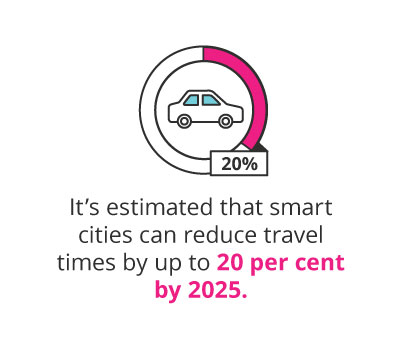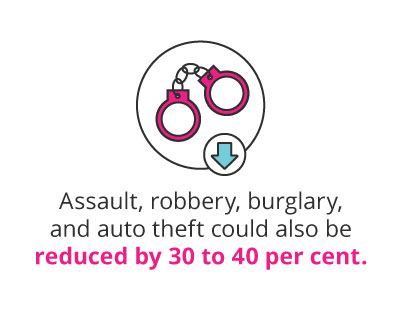Smart City Applications: Utilising Technology to Improve Urban Spaces
The term ‘smart city’ often evokes the image of a futuristic, science fiction-type metropolis. However, at its core, a smart city is simply one that has embraced the value of data that the internet of things (IoT) brings. By harnessing this data through machine learning (ML) and artificial intelligence (AI), it has the ability to streamline city functions such as traffic flow, crime prevention, and housing .1 The goal of all of this is to use technology to improve the quality of life of its citizens.
The truth is, smart cities are not a thing of the future, but a modern day reality. In fact, they’re becoming more prevalent as the use of data obtained by IoT devices continues to grow.2
That said, data and technology are not all that’s needed for the successful creation of a smart city. As a decade of trial and error shows, smart city strategies should begin with people, not technology.3 A city doesn’t become ‘smart’ merely through the installation of digital interfaces in city infrastructure – rather, it’s about using technology and data with intention: to make better decisions and optimise quality of life.4
This ultimate goal has many facets, from the quality of breathable air in the city, to how safe citizens feel walking the streets – and how cities go about achieving these things is evolving. 5 More and more cities are opting to give their citizens more decision-making power by increasingly putting data in their hands in order to tap into the city’s collective intelligence. By adopting a platform approach, constituents can use technology to capture what they believe core city operations should look like. In doing so, they democratise the city’s development, make businesses more participative, and produce a core group of citizen co-developers for smarter, more collaborative cities. Others are utilising the increasing amount of wearable and connected devices and allowing citizens to co-create data by photographing and reporting problems to municipal services .6
Here are more ways in which smart cities are utilising technology to improve urban spaces.
Smart city applications: How the IoT can improve urban spaces
Housing
One of the challenges faced by most major cities is the cost of housing.7 Simply creating more places to live isn’t enough to satisfy the real housing need though, as there’s typically an expectation around other facilities that are part and parcel of city-dwelling. These include amenities, like parks and restaurants, and critical services like grocery stores, dry cleaners, and so on.8 Smart cities respond to this need by taking datasets, such as traffic trends, health outcomes, unit economics, and amenities scores, and inputting them into an ML model aimed at maximising local resident happiness.
A city’s zoning rules are created in an attempt to itemise and categorise various complexities that, together, are what make up a beautiful, functional city. A systems-based approach uses algorithmic zoning and innovative technologies to improve access to housing in urban areas by working around traditional models. In many cities, bureaucracy is often the cause for delays in land acquisition, environmental studies, the approval of designs, and permits issued.9 Additionally, cities very often have large tracts of idle land that could be ideally suited to housing. McKinsey’s recent report on smart cities shows that cities that use IoT and technology to determine land use, and cities that optimise permitting processes, have brought a one to three percent reduction in citizen expenditures, lowered barriers to housing development, and have made dynamic electricity pricing and usage tracking possible.10
Mobility
Millions of people in cities all over the world experience congestion on their commute to work in some way or another, be it on gridlocked roads or in jam-packed trains and buses.11 Thankfully for commuters, it’s estimated that smart cities can reduce travel times by up to 20 per cent by 2025, depending on each city’s population density, what transit infrastructure is available, and commuting patterns.12 In a city with high density and extensive transit, technology could give back almost 15 minutes a day to the average commuter. In a developing city with more demanding commutes, they might see a reduction of between 20 to 30 minutes per day. Regardless, all cities that employ smart technology to streamline transit systems will enjoy the benefits.

There are a few ways that this can be achieved. Smart applications could include the use of digital signage or mobile apps to relay real-time information about delays to commuters, allowing them to adjust their routes on the go. The installation of IoT sensors on the city’s existing infrastructure can mean a more proactive approach to identifying and fixing problems before they turn into breakdowns and delays.
Smart applications that relieve road congestion are more effectively used in cities where driving is the preferred mode of transport, or where buses are more commonly used.13 Syncing traffic lights more intelligently can potentially reduce average commutes by over five per cent in developing cities where people prefer to (or have to) travel by bus. Smart-parking apps can also be used to point drivers directly to available in-city parking spaces, removing the wasted time spent circling city blocks.
Sustainability and energy consumption
Since the Paris Accord, many cities have begun to include sustainability policies in their smart cities programmes under the slogan: “What gets measured gets managed.”14 IoT sensors and AI are being utilised to manage and reduce the use of energy and carbon emissions.15 Many of these programmes are successfully used to quantify and monetise climate policies. By harnessing AI-enabled weather and damage forecasting technology, they’re able to add resilience planning to their smart city initiatives. This allows them to preempt the occurrence of hurricanes, forest fires and other natural disasters, preventing the loss of lives and mitigating the potential staggering financial loss associated with these events.
Similarly, with the increase of global warming, cities are rapidly employing smart technologies to forecast and control fire, police, medical, water, sanitation, and other public services during and after disasters.16 Smart cities are also using technology to develop innovative business models, particularly around solar energy and the use of open procurement policies that allow third parties to deploy smart grids quickly, saving citizens time and money. Leaders in smart cities are learning to nurture ‘smart citizen scientists’, where everyone in the community has the opportunity to contribute to improving city services through hackathons and challenges that require the application of exponential technologies for innovation.17 This ensures a high level of citizen engagement, transparency, governance, and accountability within the city, as well as expands the potential for creative solutions to energy and sustainability challenges.
Poverty and crime
The smart city of today was born from tragedy. Since the 9/11 attacks, cities such as New York have installed 24/7 surveillance cameras and utilised AI for the monitoring and protection of public spaces through public-private partnerships (PPP) between cities and businesses.18 The use of IoT technologies, and applications like these, has the potential to reduce fatalities from homicide, road traffic, and fires by eight to ten per cent.19 For cities with a population of five million that are considered ‘high crime’ cities, this could mean 300 lives saved each year. Assault, robbery, burglary, and auto theft could also be reduced by 30 to 40 per cent. More than that, cities enjoy the immeasurable effects of freedom of movement and peace of mind.

Initially, smart cities were only focused on connecting infrastructure in order to gain better insight into the city’s operations. However, the focus of smart city applications is slowly shifting to allow for greater engagement of citizens and businesses, empowering them to improve city services and create a better quality of life for themselves. Equipped with the right data and technology, city citizens can become more proactive, connected, collaborative, and begin to participate in the city’s improvements, allowing citizens to have a positive impact on the future of the cities they call home.
Learn to harness disruptive technology for sustainable, smart city solutions with the Beyond Smart Cities: Emerging Design and Technology online short course from MIT Media Lab.
- 1 (Nd). ‘What is a smart city?’. Retrieved from Techopedia. Accessed 24 June 2019.
- 2 Tatsuno, S. (Mar, 2019). ‘The evolution of smart cities’. Retrieved from Forbes.
- 3 Woetzel, J. et al. (Jun, 2018). ‘Smart cities: digital solutions for a more liveable future’. Retrieved from McKinsey.
- 4 (Dec, 2017). ‘Voices on infrastructure: turning the smart city opportunity into reality’. Retrieved from McKinsey.
- 5 Eggers, W. et al. (Mar, 2018). ‘Forces of change: smart cities’. Retrieved from Deloitte.
- 6 Eggers, W. et al. (Mar, 2018). ‘Forces of change: smart cities’. Retrieved from Deloitte.
- 7 (Nd). ‘Expatistan’s cost of living world map’. Retrieved from Expatistan . Accessed 24 June 2019.
- 8 Crichton, D. (2018). ‘Algorithmic zoning could be the answer to cheaper housing and more equitable cities’. Retrieved from TechCrunch.
- 9 Woetzel, J. et al. (Jun, 2018). ‘Smart cities: digital solutions for a more liveable future’. Retrieved from McKinsey.
- 10 Woetzel, J. Et al. (Jun, 2018). ‘Smart cities: digital solutions for a more liveable future’. Retrieved from McKinsey .
- 11 Hannon, E. Et al. (Oct, 2016). ‘An integrated perspective on the future of mobility’. Retrieved from McKinsey.
- 12 Woetzel, J. Et al. (Jun, 2018). ‘Smart cities: digital solutions for a more liveable future’. Retrieved from McKinsey.
- 13 Liksutov, M. (Jan, 2018). ‘Building smart transport in Moscow’. Retrieved from McKinsey .
- 14 (Oct, 2018). ‘The Paris agreement’. Retrieved from UNFCCC. Accessed 25 June 2019.
- 15 Tatsuno, S. (Mar, 2019). ‘The evolution of smart cities’. Retrieved from Forbes.
- 16 Tatsuno, S. (Mar, 2019). ‘The evolution of smart cities’. Retrieved from Forbes.
- 17 (Nd). ‘Action CA15212 – citizen science to promote creativity, scientific literacy, and innovation throughout Europe’. Retrieved from COST. Accessed 25 June 2019.
- 18 Tatsuno, S. (Mar, 2019). ‘The evolution of smart cities’. Retrieved from Forbes.
- 19 Woetzel, J. et al. (Jun, 2018). ‘Smart cities: digital solutions for a more liveable future’. Retrieved from McKinsey.
